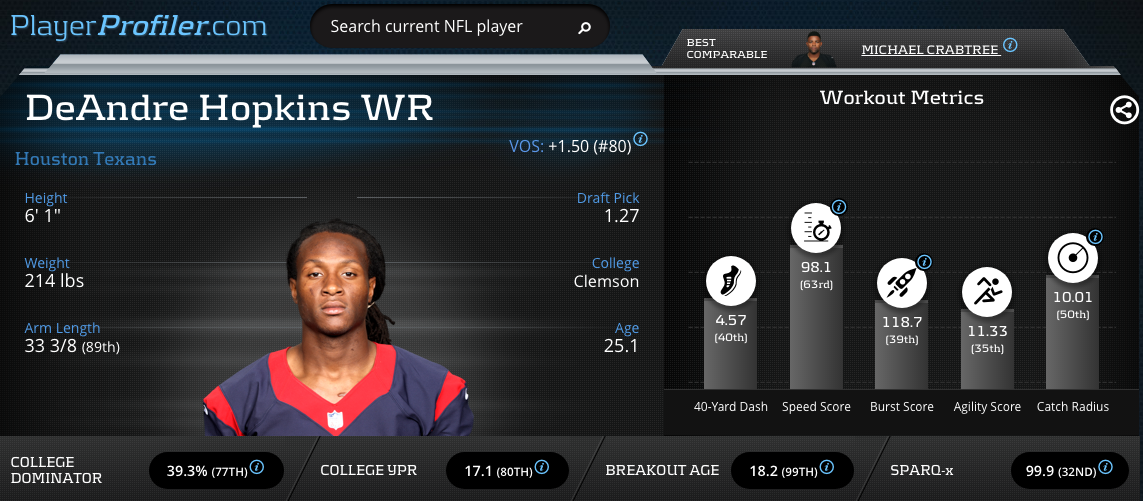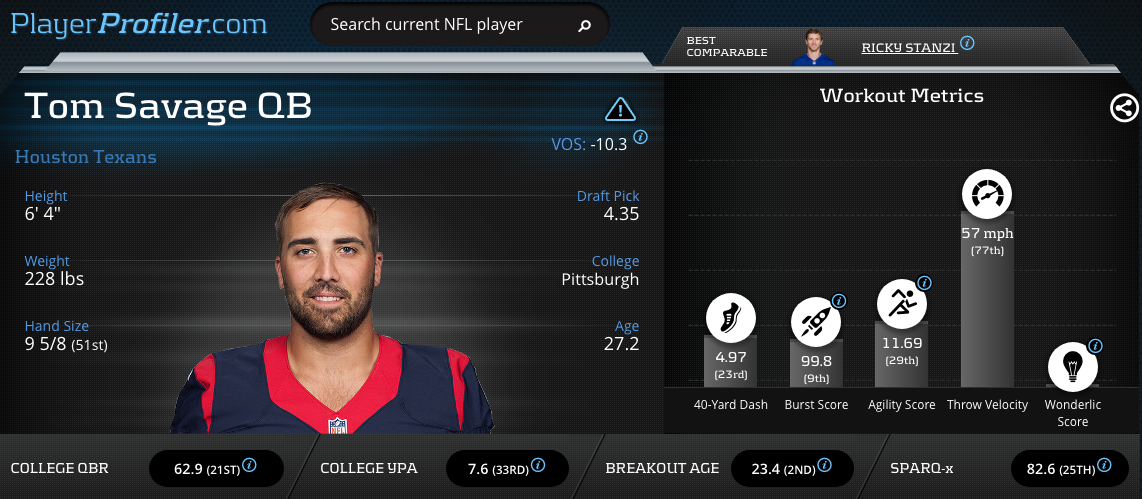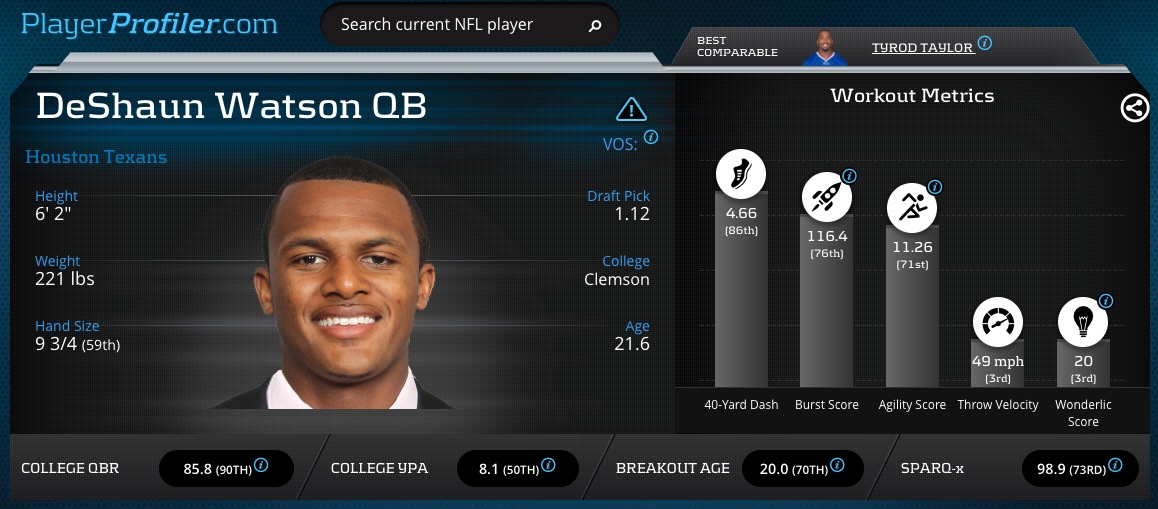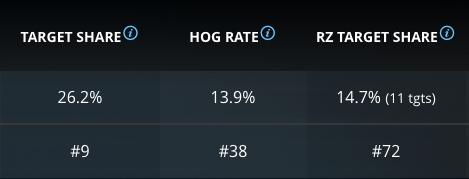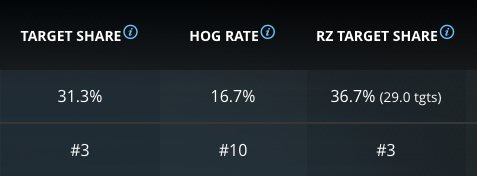Brock Osweiler didn’t ruin DeAndre Hopkins. He exposed him. Hopkins isn’t the quarterback-proof wide receiver he was touted to be coming into the 2016 season, and he is not the bounce-back candidate we are all hoping he will be in 2017. We somehow seem to be falling for the same narrative trap we fell into last year (that his quarterback play couldn’t get any worse next year), and at just a two-round discount from his 2016 ADP. His current early-third round ADP in mock drafts and rankings is setting him up for another season of disappointing fantasy owners, but savvy drafters will know to avoid him that early.
The truth is that DeAndre Hopkins is a wide receiver that depends very much on the play of his quarterback. Almost all of his production comes from the Air Yards of the passes thrown to him; in 2016 Hopkins produced just 1.6 Yards After the Catch (YAC) per target (No. 45 in the league), and in 2015 with superior quarterback play he barely scraped out 0.9 YAC per target. If the average depth of his targets is low, then his receiving yards will be low too, making him a volume-dependent receiver. As we saw with Osweiler (who often targeted his tight ends), without volume Hopkins suffers.
Why are we still drafting him so early? Let’s look at the bright side. At 25-years old DeAndre Hopkins is still very young. He has multiple seasons of productivity under his belt and has room for growth (including annual catch rate and yards after the catch improvement). As a prospect coming out of Clemson, Hopkins checked off some important boxes: stands a robust 6-1 and 214 pounds, 18.2 (99th-percentile) Breakout Age, 39.3-percent (77th-percentile) College Dominator Rating, and a above-average 98.1 (63rd-percentile) Speed Score. His first three seasons painted the picture of a budding star, marked by his improvement in receptions, receiving yards and touchdowns each year.
So what went wrong? Brock Osweiler is the obvious (read: easy) answer to that question, but let’s not be lazy. It seems more likely to me that we as a community let the statistics we liked blind us to the possibility of alternative outcomes, or used his production as an excuse not to look any deeper into the situation. We bought into a narrative because we liked the idea of a quarterback-proof wide receiver.
Now with superior quarterback play it stands to reason that DeAndre Hopkins would be able to improve his yards after the catch rate. Rumors surfaced this offseason that the Patriots had inquired about trading for Hopkins prior to the trade deadline, but unfortunately we won’t be seeing Hopkins catching passes from Tom Brady any time soon. Instead, Hopkins will have some combination of Tom Savage and rookie DeShaun Watson as his quarterbacks this year.
https://www.youtube.com/watch?v=hOh9Bt01ONY
Tom “Not-Quite-Old-Reliable” Savage
Plenty of people want to use the narrative that Tom Savage “couldn’t beat out Brock Osweiler for the starting job,” but this is another narrative that may just be masking our unwillingness to look at alternatives, or hiding our lack of definitive knowledge on the subject matter. The Texans had a vested interest in Osweiler’s success. It’s very hard to stay objective while running the risk of making a very public 72 million dollar mistake, and it’s more than understandable that the team could have wanted to give Osweiler every opportunity to succeed they possibly could, even if Savage was better. We just don’t know. I think it’s more productive for us to look at the games Savage actually did play instead of the ones he didn’t.
That being said, Tom Savage’s sample size from the season is too small for us to say for certain whether or not he’ll be a competitive quarterback in 2017. What we did see? Not impressive. Over about two games and playing against middle-of-the-road defenses, Savage failed to throw any touchdowns and averaged 6.3 Yards per Attempt, close to the lowest in the league. DeAndre Hopkins finished Weeks 15 and 16 (with Savage) with stat lines of 8/87/0 and 3/43/0. Not exactly a promising indicator, but still a small sample size. We have to include these two performances in the range of outcomes for Hopkins if Savage is the starter going into the season, and these two performances are not what we should be looking for in our third draft picks.
DeAndre Hopkins’ stats with Tom Savage weren’t promising, and Savage’s Passing Productivity metrics (below) don’t give us much reason to hope:
For reference, here are Brock Osweiler’s Passing Productivity metrics:
A New Hope (Or Not)
If Tom Savage is who we think he is and DeShaun Watson takes over the mantle of starting quarterback, we have even less data to draw from. We know that Watson is an athletic, mobile quarterback, evidenced by his 98.9 (78th-percentile) SPARQ-x Score and his 435 rushing attempts for 1,934 yards over his college career. We know that Watson managed an 85.8 (90th-percentile) College QBR and broke out at an early age (20 years old, 70th-percentile). We also know that he only throws the ball 49 miles per hour, a 3rd-percentile Throw Velocity. Whether or not that inhibits his ability to translate his college success to the next level remains to be seen, but it does raise concerns from the outset. That low Throw Velocity could mean that DeAndre Hopkins’ average depth of target will be low as well, and we have already discussed his low YAC.
We have already established that DeAndre Hopkins is a volume-dependent wide receiver because of his low YAC rate over the last two seasons. If DeShaun Watson becomes Hopkins’ quarterback, there is reason for concern. Wide receiver Mike Williams, first round draft pick of the Los Angeles Chargers, was the touted No. 1 wide receiver for the Clemson Tigers. With Watson at the helm, Williams managed just a 27.0-percent (41st-percentile) College Dominator Rating. We can’t say for certain what Watson will do at the professional level, but we know that last year he didn’t shower his primary WR with targets.
DeShaun Watson’s best comparable player on PlayerProfiler.com is Tyrod Taylor, another athletic, mobile quarterback with weak arm strength. We have seen that Taylor is able to support a fantasy WR1 (when that wide receiver is healthy), but we also know that Taylor has barely eclipsed 3,000 passing yards in each of the last two seasons with the Bills. If Taylor serves as a precedent for Watson’s future NFL performance, DeAndre Hopkins would need to take another step forward and re-establish dominance in the Texans’ receiving group. In 2016, Hopkins just wasn’t the centralized focus of the offense anymore. Just take a look at his Target Share, Hog Rate and Red Zone Target Shares from 2016 and compare them to 2015:
2016:
2015:
As you can see, DeAndre Hopkins took hits across the board in 2016, partly due to the poor quality of the offense overall and partly because other receivers (notably C.J. Fiedorowicz and Ryan Griffin) each stepped up and took shares of the team’s targets. In fact, Ryan Griffin had a 14.7-percent Hog Rate, higher than Hopkins’ 13.9-percent, and C.J. Fiedorowicz drew one more red zone target than Hopkins over the course of the season. The Texans made it clear that they are happy with their tight ends, re-signing Griffin to a three-year deal. Hopkins would need to seize the opportunity back from the tight ends, especially in the red zone, for him to become a WR1 again.
Historical Precedents
Rich Hribar at RotoWorld recently researched teams that started rookie quarterbacks and how their offense fared that year. The result? Teams that had rookie quarterbacks start five or more games in a season are unproductive for fantasy purposes, rarely finishing in the top half of NFL teams in points scored and often scoring close to the fewest points in the league. You may or may not be a fan of DeShaun Watson, but know that rookie quarterbacks have historically been weak for the fantasy production of their team before drafting DeAndre Hopkins, and that hoping for a repeat of Dak Prescott is a low-probability play. If for some reason you haven’t checked out that article, do yourself a favor and check it out now.
Check out DeAndre Hopkins on the Updated PlayerProfiler Seasonal & Dynasty Rankings:
Lastly, let’s also not forget that the Texans are a run-first team. During DeAndre Hopkins’ big season, the Texans lost Arian Foster, their key offensive component. In 2015 the Texans ranked No. 9 in pass attempts, compared to No. 30 in the league the previous year. In 2016 with a struggling Lamar Miller, the Texans ranked No. 14 overall in pass attempts. If the Texans have a healthy running back they are a run-heavy team; they ran the ball 456 times in 2016, No. 6 overall in rushing attempts in the league. The Texans may not skew as run-heavy as a team like the Bills, but they run enough to limit opportunity in the passing game.
Conclusion
DeAndre Hopkins is a very risky pick in the third round. He is still being drafted as if the Texans will return to their 2015 form, despite how closely their current situation resembles their 2016 season. If you draft Hopkins at that spot, you are expecting him to take back the majority share of the team’s targets after a down year in that respect, and for the level of his quarterback’s play to surprise the field. He may still have boom weeks, but his upside is gone for the 2017 season. It is far more likely he finishes 2017 closer to his WR35 points-per-game 2016 season than his WR5 finish from 2015.

